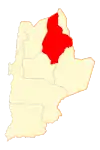Calama, Chile
Calama is a city and commune in the Atacama Desert in northern Chile. It is the capital of El Loa Province, part of the Antofagasta Region. Calama is one of the driest cities in the world with average annual precipitation of just 5 mm (0.20 in). The River Loa, Chile's longest, flows through the city. Calama has a population of 147,886 (2012 census).
Calama | |
|---|---|
 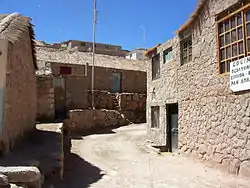 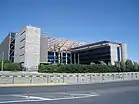 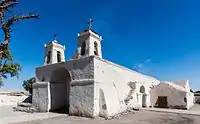  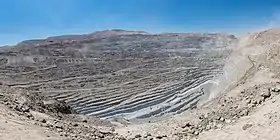 From left to right: Norte Grande, Historical town of Ayquina, Codelco corporate building, Church of San Francisco de Chiu Chiu, El Tatio and Chuquicamata | |
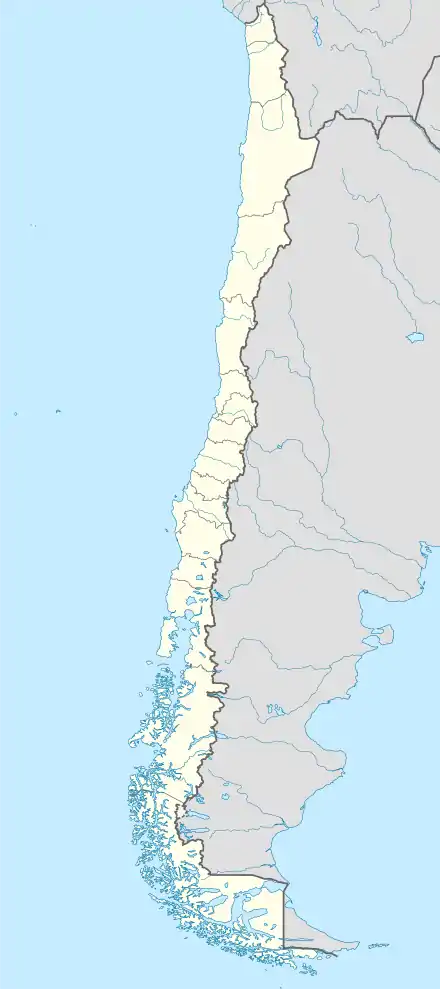 Calama Location in Chile | |
| Coordinates (city): 22°28′S 68°56′W | |
| Country | |
| Region | |
| Province | El Loa |
| Government | |
| • Type | Municipality |
| • Alcalde | Daniel Agusto Pérez |
| Area | |
| • Total | 15,596.9 km2 (6,022.0 sq mi) |
| Elevation | 2,260 m (7,410 ft) |
| Population (2012)[2] | |
| • Total | 147,886 |
| • Density | 9.5/km2 (25/sq mi) |
| • Urban | 136,600 |
| • Rural | 1,802 |
| Demonym(s) | Calamenian |
| Sex | |
| • Male | 70,832 |
| • Female | 67,570 |
| Time zone | UTC−4 (CLT) |
| • Summer (DST) | UTC−3 (CLST) |
| Postal code | 1399001 |
| Climate | BWk |
| Website | Official website (in Spanish) |
The commune also encompasses the Quechuas communities of Estación San Pedro, Toconce and Cupo; and the Lickan-antay communities of Taira, Conchi Viejo, Lasana, San Francisco de Chiu Chiu, Aiquina-Turi, and Caspana.
In 2003 the nearby town of Chuquicamata, once the largest open-pit copper mine in the world, was dismantled citing environmental reasons and encroachment from the mine's expansion. Residents of Chuquicamata then moved to Calama, away from company-owned residences, to find housing on their own.
Etymology
There are a variety of hypotheses about the origin of the name "Calama," but the two main accounts suggest that it comes from the Kunza language, spoken in the past by the Lickan-antay, an ethnic group that resides in the El Loa Province.
Hector Pumarino Soto suggests that "Calama" stems from the Kunza word "Ckara-ama," which means "town in the middle of the water". Until the middle of the 20th century, the urban site of Calama and the surrounding oasis were flanked by the River Loa on two sides, and the fertile plain and swamps on the other sides, giving the location the appearance of an island in the middle of the desert surrounded completely by water.
Emilio Vaïsse, meanwhile, says that Calama comes from the Kunza word "Ckolama," which means "place where partridges abound".[4] This is supposed testimony to the abundance of such a bird, living over everything in the middle of the western swamp sector.
History
Prehispanic Era
The exact evidence related to the history of Calama does exist, including petroglyphs and the caves of Yalquincha (NE of the city), the chullpas of Topáter (pre-Columbian cemeteries to the east of the city), the Copper Mummy, and other remains in Chuquicamata.
At the intersection of the Camino del Inca (the longitudinal one) and the routes that crossed the coast of the Altiplano, Calama became the main shelter of the Despoblado of Atacama. Their extensive lands for growing corn and alfalfa give testimony of the high capacity to supply food to the troops of Chasquis and to give tribute to the Inca. In fact, when Diego de Almagro, returning from Cusco, passed by the Calama shelter, the natives gave him copper horseshoes, which were made using a mysterious Incan technique used by towns conquered by the Incas. The science of such a technique still has yet to be explained, but the presence of such horseshoes further suggests strong Incan influence in Prehispanic times.
Colonial Era
Spanish colonization obviously caused some changes; however, the hostile climate impeded establishment of greater control. These changes influenced the control of trade routes that crossed the desert and communication to the port of Cobija with the deposits of Potosí silver and the cattle farms of Salta and Tucumán. In this sense, Calama continued as a main point of provision for commercial routes. In the 18th century, with the Bourbon Reforms, Calama depended directly of the Intendencia de Potosí.
Bolivian Republic Era
After Bolivia's Declaration of Independence (6 August 1825), and with gradual changes in the administration of the territory, Calama remained constituted under the Departamento de Litoral (1829), subdivided in the Provincia de Lamar y la Provincia de Atacama (Cobija being the departmental capital). Calama was an important town in the Atacama Province, through which traveled the weekly mail between Cobija and Salta-Potosí, since 1832. In 1840, the provincial capital transferred from Chiuchiu to Calama, increasing the communication boom.
The border conflicts between Chile and Bolivia did not reach either Calama or the Atacama Province. The greater dispute concentrated in the central prairie and in the coast, where they began to discover rich silver deposits, saltpeter, and guano. The ambiguity that led to the frontier conflicts was the possession of the central plain and the Atacama coast. The environment was made tense when Chilean troops, under the command of colonel Emilio Sotomayor Baeza, invaded the port of Antofagasta on the morning of February 14, 1879. Later, Bolivia declared war on Chile on March 1.
Chilean Republic Era
Since that day, the changes in the administration have been very deep. It being part of the administrative center of 2° order in Bolivia, returned as one of 4° order under the Chilean administration (subdelegation). In 1888, under the government of José Manuel Balmaceda, Calama returned as an administrative center of 3° order, inaugurated as the municipality on 13 October. Prior to that, in 1886, Calama was chosen for a railway station of the Antofagasta-Bolivia Railway, which further expedited shipments through Calama.
Geography and Climate
Calama contains two distinct entities: the desert and the Andes Mountain Range. Between 2,000 and 3,000 m (6,562 and 9,843 ft), the desert climate (BWh) is characterized by annual precipitation that does not surpass 35 millimetres (1.4 in). The average temperature is 11.2 °C (52.2 °F) throughout the year with drastic changes between average daily highs of over 20 °C (68 °F) and average daily lows below 0 °C (32 °F) in winter and record highs of over 30 °C (86 °F) in summer. Light easterly winds are common in the mornings with strong westerly winds in the afternoon.[5] It is believed to be the third sunniest place in the world.
| Climate data for Calama (1981–2010, extremes 1967–present) | |||||||||||||
|---|---|---|---|---|---|---|---|---|---|---|---|---|---|
| Month | Jan | Feb | Mar | Apr | May | Jun | Jul | Aug | Sep | Oct | Nov | Dec | Year |
| Record high °C (°F) | 30.3 (86.5) |
30.4 (86.7) |
29.8 (85.6) |
29.6 (85.3) |
29.4 (84.9) |
30.6 (87.1) |
30.6 (87.1) |
30.3 (86.5) |
29.6 (85.3) |
30.4 (86.7) |
30.0 (86.0) |
30.0 (86.0) |
30.6 (87.1) |
| Average high °C (°F) | 24.5 (76.1) |
24.5 (76.1) |
24.0 (75.2) |
23.3 (73.9) |
22.0 (71.6) |
21.1 (70.0) |
20.8 (69.4) |
22.1 (71.8) |
22.9 (73.2) |
24.0 (75.2) |
24.5 (76.1) |
24.8 (76.6) |
23.2 (73.8) |
| Daily mean °C (°F) | 15.4 (59.7) |
15.5 (59.9) |
14.8 (58.6) |
13.2 (55.8) |
11.6 (52.9) |
10.5 (50.9) |
9.9 (49.8) |
11.1 (52.0) |
11.8 (53.2) |
13.0 (55.4) |
13.7 (56.7) |
14.7 (58.5) |
12.9 (55.2) |
| Average low °C (°F) | 6.2 (43.2) |
6.4 (43.5) |
5.6 (42.1) |
3.2 (37.8) |
1.2 (34.2) |
0.0 (32.0) |
−1.1 (30.0) |
0.2 (32.4) |
0.8 (33.4) |
1.9 (35.4) |
3.0 (37.4) |
4.5 (40.1) |
2.7 (36.9) |
| Record low °C (°F) | −3.0 (26.6) |
−4.0 (24.8) |
−3.0 (26.6) |
−9.5 (14.9) |
−7.6 (18.3) |
−9.1 (15.6) |
−9.6 (14.7) |
−12.5 (9.5) |
−7.0 (19.4) |
−7.5 (18.5) |
−6.0 (21.2) |
−2.2 (28.0) |
−12.5 (9.5) |
| Average precipitation mm (inches) | 0.4 (0.02) |
0.8 (0.03) |
0.2 (0.01) |
0.1 (0.00) |
1.2 (0.05) |
2.0 (0.08) |
0.6 (0.02) |
0.3 (0.01) |
0.2 (0.01) |
0.1 (0.00) |
0.0 (0.0) |
0.0 (0.0) |
5.9 (0.23) |
| Average relative humidity (%) | 42 | 47 | 47 | 39 | 34 | 34 | 33 | 31 | 32 | 32 | 31 | 36 | 37 |
| Mean monthly sunshine hours | 353.4 | 305.1 | 319.3 | 312.0 | 306.9 | 297.0 | 310.0 | 316.2 | 321.0 | 356.5 | 363.0 | 365.8 | 3,926.2 |
| Mean daily sunshine hours | 11.4 | 10.8 | 10.3 | 10.4 | 9.9 | 9.9 | 10.0 | 10.2 | 10.7 | 11.5 | 12.1 | 11.8 | 10.8 |
| Source 1: Dirección Meteorológica de Chile[6][7] | |||||||||||||
| Source 2: Universidad de Chile (sunshine hours)[8] | |||||||||||||
Orography

The western boundary of the town of Calama is marked by the peaks of the foothills, which occurs north of Calama in the foothills of the Loa River, which has many names, from north to south: Sierra Moreno, Cerros Chuquicamata Cerros de Montecristo. The Cerro Poquis (4,589 m), is the maximum altitude, north of Chuquicamata. South of it begin the foothills of the Cordillera de Domeyko, which in turn serve to chart the southern boundary of the district, with the names of Sierra de Limón Verde and Cordon Barros Arana. The passage of Loa river from east to west leaves a plain, in which the city of Calama and the oasis is located.
Demographics
According to the 2002 census of the National Statistics Institute, Calama has an area of 15,596.9 km (9,691 mi) and has 138,402 inhabitants (70,832 men and 67,570 women). Of these, 136,600 (98.7%) lived in urban areas and 1,802 (1.3%) in rural areas. The population grew by 3.6% (16,595 persons) between the 1992 and 2002 censuses.[2]
Administration
As a commune, Calama is a third-level administrative division of Chile administered by a municipal council, headed by an alcalde who is directly elected every four years. The 2008-2012 alcalde is Esteban Velásquez Núñez.
Within the electoral divisions of Chile, Calama is represented in the Chamber of Deputies by Mr. Marcos Espinosa (PRSD) and Mr. Felipe Ward (UDI) as part of the 3rd electoral district, (together with Tocopilla, María Elena, Ollagüe and San Pedro de Atacama). The commune is represented in the Senate by Carlos Cantero Ojeda (Ind.) and José Antonio Gómez Urrutia (PRSD) as part of the 2nd senatorial constituency (Antofagasta Region).
Transportation
Calama is served by the El Loa Airport.
References
- "Municipality of Calama" (in Spanish). Retrieved 3 November 2010.
- "National Statistics Institute" (in Spanish). Retrieved 7 September 2010.
- "Topographic Map of Calama from Google Maps".
- Vaisse, Emilio F. (1 January 1895). "Glosario de la lengua atacameña". Anales de la Universidad de Chile (in Spanish): 533. doi:10.5354/anuc.v0i-.20911. ISSN 0717-8883.
- https://www.wunderground.com/q/zmw:00000.21.85432
- "Datos Normales y Promedios Históricos Promedios de 30 años o menos" (in Spanish). Dirección Meteorológica de Chile. Retrieved 7 December 2018.
- "Temperatura Histórica de la Estación El Loa, Calama Ad. (220002)" (in Spanish). Dirección Meteorológica de Chile. Retrieved 7 December 2018.
- "Tabla 4.6: Medias mensuales de horas de sol diarias extraídas del WRDC ruso (en (hrs./dia))" (PDF). Elementos Para La Creación de Un Manual de Buenas Prácticas Para Instalaciones Solares Térmicas Domiciliarias (in Spanish). Universidad de Chile. September 2007. p. 81. Retrieved 13 July 2015.
| Wikimedia Commons has media related to Calama. |
External links
- (in Spanish) Municipality of Calama


